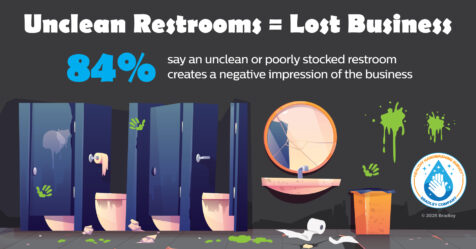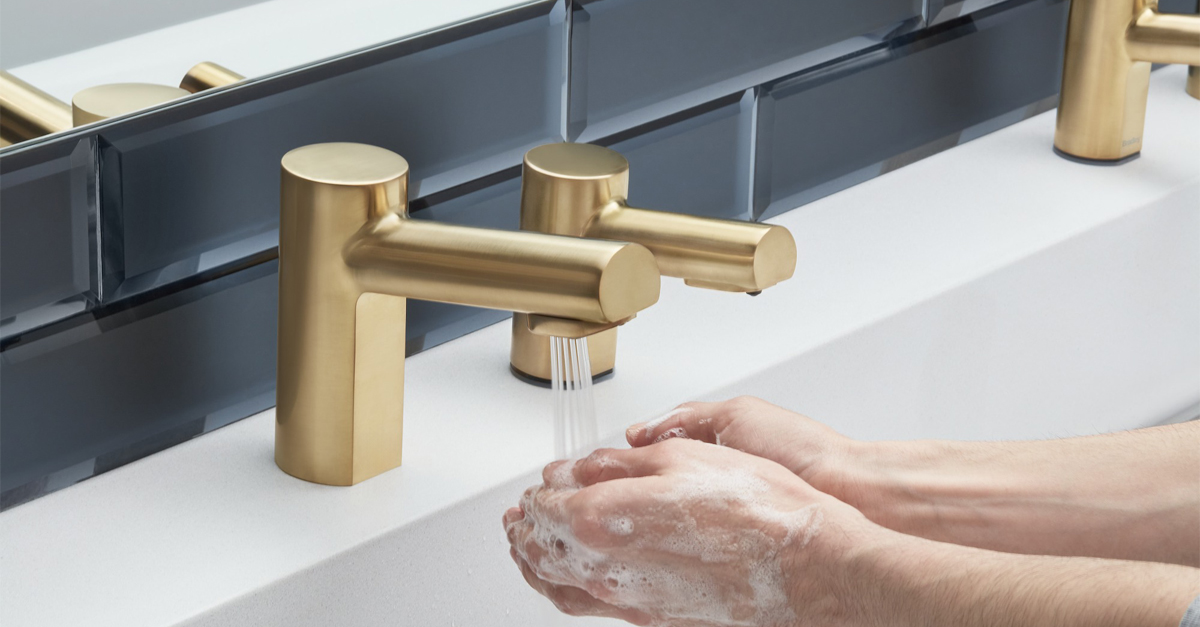Restrooms are more than a basic building amenity. They’re an important reflection of a facility’s overall cleanliness, professionalism, and management. As such, a restroom is a very memorable space, good or bad.
According to Bradley’s 2025 Healthy Handwashing Survey™, customers are keenly paying attention to the condition of restroom spaces, with 84% saying an unclean or poorly stocked restroom leaves a negative impression of the business. More telling still, 71% are more likely to return—and spend more money—at a facility with clean, well-maintained restrooms.
These numbers don’t just underscore the value of a tidy restroom; they make the case for smarter, more efficient restroom design and maintenance strategies. For facilities of all types—including retail stores, hospitality venues, office buildings, airports and stadiums—the restrooms can influence brand perception, staff efficiency, and customer satisfaction. So how can cleaning and maintenance teams rise to meet these expectations?

Clean restrooms boost business
A well-kept restroom isn’t just a matter of hygiene; it’s a business strategy. Poor restroom conditions and experiences can drive customers away silently, without complaints, but with lasting effects. According to the survey, 75% say a bad restroom experience makes them think twice about returning.
As more convenience stores, restaurants, and mixed-use spaces offer food service, restroom cleanliness becomes a proxy for overall cleanliness. In fact, 90% of Americans believe a dirty restaurant restroom likely indicates a dirty kitchen.
With these stakes in mind, the focus shifts from reactive cleaning to proactive design and maintenance. Five design and equipment features can make restrooms stand out.
1. Touchless fixtures
Touchless restroom fixtures are now the gold standard in hygiene and maintenance. Nearly 80% of Americans surveyed say touchless fixtures are important in public restrooms and 75% prefer using them compared to manual fixtures because the touchless fixtures improve their overall restroom experience.
From faucets and soap dispensers to towel dispensers and hand dryers, sensor-activated fixtures offer a triple win:
- Hygiene: They reduce germ touchpoints and limit cross-contamination.
- Efficiency: Users move more quickly through restrooms, reducing congestion.
- Maintenance: Without handles and levers to wipe down, staff save time during cleanings.
- Less waste: Using automatic hand dryers significantly cuts down on paper towel waste and overflowing trash receptacles. Touchless paper dispensers help regulate how many towels are dispensed, curbing excess consumption of paper that often ends up on floors.
2. All-in-one handwashing systems
An emerging trend in commercial restroom design is all-in-one handwashing fixtures, which integrate soap, water, and hand drying in a single unit. This model keeps handwashing elements in easy reach, creating an accessible and convenient way to wash hands. The design, engineered to keep water inside the bowl, also eliminates the common problem of water trails across the restroom floor caused by people moving from the sink to a wall-mounted dryer. It also reduces maintenance issues like slippery floors, water damage on counters, and messy soap drips.
From a design standpoint, these units offer a sleek, modern appearance that’s appealing to both guests and cleaning teams. Fewer individual components mean fewer surfaces to clean and fewer fixtures to monitor.
3. Smarter soap and towel dispensers
One of the most frustrating experiences for restroom users—and one of the most avoidable—is running out of soap or paper towels. These shortages frustrate guests and can lead to missed handwashing, poor hygiene, and negative reviews. In fact, better cleaning and restocking is the No. 1 improvement Americans would like to see in public restrooms.
Staying on top of soap refills, especially in high traffic restrooms, is also a common headache for facility staff.
Newer soap and towel dispenser models are solving the issue of soap refills with visual maintenance indicators that alert staff when a refill is needed or a battery is low. Instead of wasting time checking every dispenser, cleaning crews can prioritize where attention is needed.
Some soap systems go further with top-fill, multi-feed technology. A single large-capacity reservoir can feed multiple dispensers, cutting refill time, preventing outages, and eliminating the inconsistency of staggered refills. For busy facilities or locations with limited staff, this is a maintenance game changer.
4. Accessibility and user comfort
Restroom success isn’t just about equipment; it’s about accessibility and the total user experience.
Often, it’s the little things that make a big difference.
- Hooks and shelves: Customers appreciate thoughtful features like coat hooks and bag shelves. According to survey results, these were among the top amenity requests.
- Spacious layouts: Crowded stalls and tight turning radii are a turnoff for customers, especially those with mobility needs. A spacious layout is not just compliant with the Americans with Disabilities Act; it’s a comfort requirement.
- Soft-closing doors and occupancy indicators: Reducing noise and improving privacy—particularly with restroom partitions—can enhance the user experience and minimize disruption, particularly in shared spaces. Full-length restroom partitions are also becoming more popular in the quest for user privacy.
These small design decisions reflect attention to detail, and by extension, overall facility care.
5. Coordinated fixtures and durable finishes
Facility managers know that consistency matters, especially when it comes to cleaning routines. Restrooms with coordinated fixtures (in terms of colors, finishes, shapes, and mounting heights) allow for streamlined training, standardization across properties, and easier inventory management—not to mention aesthetics.
Choosing fixtures and accessories with durable, fingerprint-resistant finishes also reduces daily cleaning. For handwashing basins, solid surface materials and quartz lavatory decks resist staining, moisture buildup, and microbial growth. Nonporous, seamless surfaces cut cleaning time and reduce the spread of germs.
Even newer paper towel dispenser models have been improved with smooth surfaces (no visible seams or openings), wall-saving designs, and anti-slam doors that avoid damage during refills.
A clean restroom is a smart investment
Today’s restroom is a business touchpoint, a brand ambassador, and a barometer for operational excellence. Customers notice the difference, and they vote with their wallets.
Designing restrooms with cleaning in mind not only makes the janitorial team’s job easier; it also extends fixture life, boosts satisfaction scores, and reinforces a commitment to public health and safety. Technology like touchless fixtures, refill indicators, and top-fill systems reduces manual workload, while thoughtful design elements like coat hooks, sound suppression, and larger stalls enhance comfort.
Facility teams that take a proactive, user-first approach to restroom design and maintenance aren’t just keeping things clean; they’re elevating the entire customer experience.



